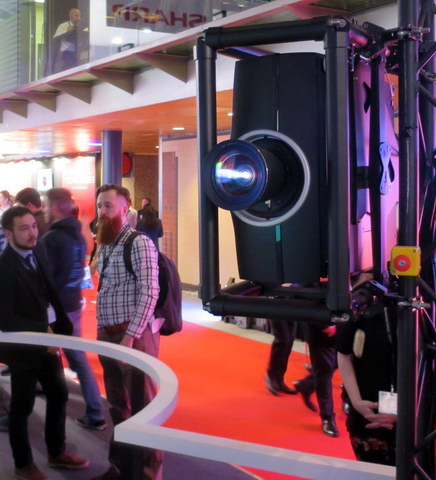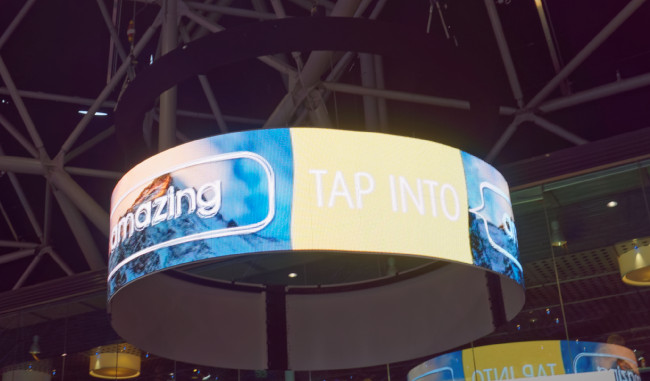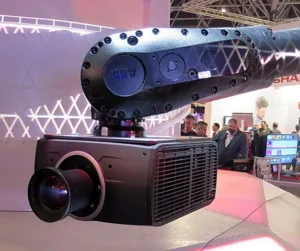Barco was showing two new projectors in its booth at ISE: the F90-4K13 and the F70. Both were laser phosphor based. In fact, according to Kristien Kolstad, Director of R&D and Product Management, Projectors, all future projector developments at Barco will be laser-phosphor, RGB laser or LED. No new lamp-based projectors will be developed or introduced.
The F70 series of single panel DLP Barco projectors has two new versions added with UltraHD (F70-4K6) and WUXGA (1920 x 1200) resolutions. The Barco website lists the resolution of the F70-4K6 as “3,840 x 2,400 (4K UHD) / 2,560 x 1,600 (native).” This is greater than UHD resolution with a 16:10 aspect ratio and is derived from the native resolution by pixel shifting. Kolstad told me these projectors can have up to 8000 lumens output and up to 60,000 hours of life at 65% laser power. The F70 projector in the Barco both at ISE was mounted on a robot arm which could move it around and orient it in any position. The photo shows it horizontal but upside down, as if it were ceiling mounted. This was done not only to show the freedom from mounting restrictions, but because modern live entertainment often uses projectors on motion bases, this projector would be well suited to this application. According to Barco, “The F70 projector is a perfect fit for fixed installation in a wide variety of venues and visitor attractions such as museums, theme parks, auditoriums, and science centers. And thanks to its motion platform compatibility, it’s a perfect match for theme park dark rides.”
Barco F70 on a robotic arm at ISE
The Barco F90-4K13 projector is also a single panel DLP projector using a 0.9” DLP imager to generate a 16:10 4K UHD (3,840 x 2,400) resolution after pixel shift. It uses a laser phosphor light source with a lifetime of 20,000 to 40,000 hours, brightness mode dependent. Like the F70, it can be used on a motion base and in any orientation with no restrictions.
 One of five Barco F90 projectors at ISE
One of five Barco F90 projectors at ISE
Both the F70 and the F90 projectors use Barco’s FLD and FLD+ lenses which range from ultrashort throw (0.3:1) to long throw (9.75:1). Both projectors also have lens shift.
The F70 on the robot arm was projection mapping onto a model of Barco’s ‘One Campus’ headquarters, in combination with five F90 projectors. While this setup showed off the capabilities of both the F70 and the F90 projectors, the F70 and the robotic arm often shadowed the images from the F90 projectors, showing how difficult it is to create content for a system with a moving projector. –Matthew Brennesholtz
Clickshare Upgraded
Barco was showing the latest version of its Clickshare product, the ClickShare 800 which is designed for large meeting rooms and board rooms. The big change compared to previous versions is that it can support up to dual UltraHD displays and can also support eight support devices, up from four. The new version can support moderation of the content, so that one moderator can both see multiple sources and can control which is shown, rather than simply relying on pressing the dongle. The new version also supports annotation and content shown on the display can be saved to a PDF, with the annotations to make content easier to share. Barco highlighted that the system can be used without access to corporate networks as Wi-Fi Direct is used for connections.
Clickshare 800 will sell for €4,999 and will start to ship in May.
The company also had its LEDs on show. There was a large circular display that was being hung from just a few cables, showing how the latest lightweight and flexible R series (shown at ISE and ProLight & Sound last year and launched at Infocomm) can be used in ways that would be challenging for traditional LED configurations. At the moment, the R Series is only available in 10mm pitch, but there will be an additonal pitch at Infocomm. The X Series, which has integrated processing, was also being shown. However, Barco also had a demonstration showing how its Laser cubes could be brighter than LEDs, with lower energy usage and longer lifetime, while being less work to install.
Of course, controllers are a key part of LED solutions and Barco was highlighting the Infinipix controller which was achieving a high frame rate without the tearing that could be seen on other displays (the ones showing video) Features include auto calibration so that if a module is replaced, the new LEDs are immediately matched to the existing ones.


